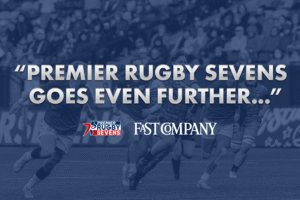Written By: Tom Hamilton
Source: ESPN
DUBLIN, Ireland — Expect to hear the word “runway” a lot over the next decade in and around rugby corridors. That’s the crux of why World Rugby announced the hosts of the next five Rugby World Cups on Thursday — to give the sport enough time to plan their next global gatherings with precision, sustainability and a goal of maximising their impact.
The announcement in Dublin at the Convention Centre sounds the starting bell to a nine-year build-up to the 2031 men’s Rugby World Cup in the U.S., followed two years later by the women’s tournament. This is a monumental statement of intent from the sport to try and crack that elusive market once and for all. But before the 2031 and 2033 World Cups come four other editions. With the men’s tournament in France in 2023 already confirmed, attention will then shift to England for the women’s 2025 World Cup before Australia then play host to both the men’s and women’s in 2027 and 2029, respectively.
This is all part of a new model for World Rugby — the body in charge of the sport. Previously, individual countries would try and tempt the council to vote for their vision of a World Cup, make a financial guarantee and then run it themselves. But under the guise of new CEO Alan Gilpin, this model has changed and instead of a host country getting near autonomy to run the tournament, World Rugby are now joint partners in any future competition. This gives the sport enough breathing room to map out the next decade. The runway’s there for the sport, now they just have to get the planes in the right order and with the correct amount of fuel, and passengers aboard.
The historic announcement comes at yet another tipping point moment for the sport. The conversations in and around rugby’s corridors of power over the past couple of days have been around the global calendar, and how they can align the north and south’s schedules, while also developing the Tier 2 nations, who so often have to live off scraps from the top table. For the women’s game, the introduction of the new WXV tournament shows progress there but still, the hope is the next decade of World Cups will help propel the sport to a new level both in terms of participation and awareness.
After France 2023, attention will shift to England. The organisers of the 2025 Women’s World Cup will pay close attention to how the country delivers this summer’s women’s European Championships in football, but it is a tournament already with over £10m funding behind it from the government for the legacy programme with the goal of securing 60,000 new players in the game, alongside 1,000 match officials and 500 coaches. The newly expanded tournament sees 16 teams compete instead of the previous 12 and will end up at a sold-out Twickenham. The form of the England team at present will also aid the cause to make this the most highly attended women’s Rugby World Cup in history, with Simon Middleton’s team No. 1 in the world, 23 matches unbeaten and overwhelming favourites to lift the title later this year in New Zealand.
The focus of the rugby world will then head to the southern hemisphere for the 2027 men’s World Cup and the 2029 women’s World Cup. For Australia, it gives the sport a chance to right the wrongs of the 2003 legacy, where the AUS$45 million generated hardly led to sustained success at club, or country level. The sport still lives in the shadow of Australian Rules football, rugby league, cricket and soccer, but as Hamish McLennan, the Rugby Australia chairman says, getting both tournaments — as part of Australia’s decade of sport including the 2025 British & Irish Lions tour and 2032 Olympics — means they can “reboot” the sport in the country.
McLennan sees the two World Cups as an opportunity for the money generated to become an “investment vehicle to drive long-term sustainability” while also providing “the necessary runway to fix structural issues in the game and to provide a platform to showcase this global game.” Australia came to the party late offering to host the 2029 women’s Rugby World Cup, but they’ll also use this chance to change the Wallaroos’ fortunes after they had to wait 958 days between Tests before beating Fiji at the weekend, and then losing to Japan on Tuesday.
If the Australian bid is as close to a sure thing success story as possible, then awarding the following World Cup to the U.S. is a risk. There have been numerous false dawns for rugby in the U.S. Their match back in 2014 against the All Blacks at Soldier Field was billed as the moment the giant awakened, but it did little than enjoy a brief moment in the spotlight and then slip back into the unknown. When CEO Ross Young joined the organisation in 2018, USA Rugby was in financial strife at the time — a series of agreements with external companies had proven to be poor investments, and while the intentions were all with the goal of turning this part of the world into a rugby stronghold, there weren’t any foundations beneath the grandiose plans.
In June 2020, six years after that false dawn in Chicago, USA Rugby filed for bankruptcy — that announcement coming just a couple of years after World Rugby stumped up $4m to cover the outstanding cost of hosting the World Cup Sevens in 2018 in San Francisco. The knock-on effects of COVID-19 had ruined the organisation. “Not overstating, it was the worst six months, seven months of my life,” Young tells ESPN. “Not just dealing with a pandemic, but trying to keep things afloat with the support of keeping young, great people with some losing their jobs. It’s soul-destroying.” The organisation successfully came through the process by the end of August 2020 and they’ve since rebuilt. But the scars run deep, and those lessons will prove invaluable for how they negotiate the “runway” — as they call it — in the run-up to 2031 and 2033.
“We’ve learned some very harsh lessons other last few years, and we can’t live hand to mouth, which has happened for years,” Youngs says. “It takes something like COVID-19, and you can’t exist through it. But how do we know to build in the right way without trying to run before we can walk?”
The U.S. has long been seen as the “north star” for the sport, as one source puts it. There have been many attempts to crack the market, but none have yet succeeded. But a combination of factors like the continued presence of rugby in the Olympics, women’s rugby granted NCAA emerging sport status, the growing footprint of Major League Rugby (MLR) and an acceptance of where things went wrong in the past, means there is optimism around the next decade. The World Cup, as USA Rugby’s COO Johnathan Atkeison says, offers the country “the opportunity to turn those glimpses of potential into a sustainable and concrete reality.”
The whole process is expected to cost in the region of $500m and has received bipartisan support, alongside the seal of approval from President Joe Biden, who wrote a letter to World Rugby chairman Sir Bill Beaumont promising regulatory support and infrastructural guarantees. The possibility of external investment is also hovering above this bid, with one source telling ESPN that once Silver Lake complete their investment in the All Blacks, they could turn attention to the U.S. There’s a huge market there to be tapped into.
The 2031 and 2033 World Cups have 25 or so venue bids on the table from all over the country. World Rugby delegates have already been shown around the Denver Bronco’s impressive Empower Field home. One possibility could see the tournament start in the west of the country and gradually move east. “We want to build towards something and building towards one of the biggest geographies,” Young says. There is also the possibility of using localised pools, where each group plays in a different part of the country before congregating for its grand finish.
The destination of the final is yet to be decided, but the smart money would be on New York hosting the showpiece event. “That’s all the detail that we’ll get stuck into,” Young says. “We’re a little bit spoilt for choice because there are there are a number of hubs — it’s not just like England, where the final could only be Twickenham or Wembley.”
Another factor the organisers must figure out is when to schedule both tournaments (not an easy thing when it comes to the annual machinations and continued filibustering around the global calendar). Sources say World Rugby would prefer it stays in its existing October-November window, but that would clash with the NFL season and may render some potential venues unavailable. But the expectation is middle ground will be found to satisfy all parties, which begs the question to what exactly both World Cups will feel like.
Jim Brown, the USA Rugby World Cup bid chair, has held roles at FIFA and was a key figure in bringing the 2028 Olympics to Los Angeles and football’s 2026 World Cup to the U.S. His vision for the World Cup, and the one proposed, will see it marry tradition with unique local nuances. “I don’t think it’d be a revolution,” Brown tells ESPN. “Certainly there’s a natural tendency to absorb some of the local culture, which we hope everybody finds at some stage to be a positive for the overall game, and not necessarily impacting those who are more traditionalist in a negative way at all.”
But anchoring it all is legacy and leaving a footprint of sustainable interest and participation in the sport, and a grassroots system which can help grow the national teams. Essential to this all is buy-in from the various stakeholders. The involvement of World Rugby as partners in this project means they’ll be a guiding hand and will help bring the various disparate bodies to the table. MLR — sanctioned by USA Rugby but a separate body — will be essential to this, as will other leagues like the NFL and MLS, where franchises there have declared an interest in hosting matches in both World Cups (95% of bids from stadiums to host matches are for both 2031 and 2033 competitions).
Young acknowledges a widespread wish to unlock the biggest media market in the world by conquering the U.S. for the sport, but it’s about sustainability. The targets from their official bid for the World Cup included the target of expanding membership from the current tally of 109,000 up to 450,000 over the next 10 years.
To manage this, they must develop the domestic product. On the men’s side, this is MLR. Young admires how the owners are “trying to raise the level of the game to make it a product, which is appealing” but sounds a note of caution around the limited player pool. “There’s not enough American talent to go around to backfill it. So how do we ensure that that is a proper pipeline?” The league can’t rely on expensive, foreign players in the twilight years of their career, and while there have been success stories, the league has to be anchored on international American players. “The MLR has to be aligned with the bigger picture and the plan to be part of it,” Young says. “And they’re very keen to do that. So hopefully, post ratification, we’ve already lined up a number of meetings in the U.S. in June and July, with all the stakeholders to start building out the details of that.”
The MLR owners look to the model established by the MLS with envy. They highlight the impact the 1994 football World Cup had on the country’s participation numbers and how that helped plant the seeds for the MLS. “The major event philosophy from the ’90s was, what’s the legacy, and the legacy, by definition is what comes after,” Young says. “We need to pull forward a legacy and start building the legacy programme before things. We’ve got to maximise the schools programmes. We’ve already got a partnership with the MLR, and getting players when they’re on their off days to go to schools to play flag rugby.”
This is all with the goal of creating and ensuring competitive U.S. teams at both World Cups. While they have had sporadic success in Sevens, the return in XV is less progressive. Both teams are hamstrung by the current global calendar where the lack of staple fixtures means the U.S. men’s team don’t yet know who they’re playing this summer, let alone next November. It makes growing excitement, familiarity, and a narrative around both teams brutally difficult.
The U.S. men’s team face one of the biggest games in their history in June when they have their two-legged playoff against Chile for a spot in the 2023 Rugby World Cup. They simply must win. Their record in World Cups is a tale of valiant performances, but they are yet to break through into the knockout stages. While they hope to repeat Japan’s success from the 2019 World Cup, where the men’s team led a remarkable run to the quarters, Young points to how the Japanese Rugby Football Union (JRFU) prioritised the men’s 15 team in the build-up to the tournament, while USA Rugby are still trying to split their resources across both men’s and women’s XV, and sevens. “We’re a small union with limited cash trying to run four national teams,” Young says. “There’s not enough resource to go around, but we’re not going to drop them.”
Despite this, they want quarter-final finishes in both. “We have to be aggressive,” Young says. “I think the last-eight, it’s always a target that you’re looking to achieve. The women have been far more successful in the past (winning the 1991 women’s World Cup and reaching the final in 1994 and 1998) than the men have.”
This all comes back to Young’s frequent message of needing to establish stable foundations in the country in the run-up to 2031 and 2033, rather than a series of flash-in-the-pan events which momentarily pique interest in the sport but that then sizzles away.
Premiership Rugby has taken the odd game to the U.S. in the past, while the men’s team have had some marquee matches against the All Blacks — losing their last match to them 104-14 in October 2021 — but anchoring this bid is sustainability. “To me, it comes to having one-off events are great, but if you’ve not got the foundations in place to build off, then nothing is going to be sustainable,” Young says. “You could say the same thing around the 2018 Sevens World Cup in San Francisco — there were 100,000 people in an iconic stadium with the Americanisation, and everyone had a good time. Those opportunities were grand because people didn’t want to miss out. But not enough work was done in ensuring that the infrastructure was there to be able to support the knock-on effect.”
From speaking to those in and around the bid, they see the women’s game as a blank canvas full of opportunity. The NCAA Emerging Sport status women’s rugby has in the U.S. will help produce a goldmine of talent. Later this year, pro contracts will be handed out to women’s players for the first time in Premier Rugby Sevens. The team is building nicely, and the aim is to carry this progress into creating a fully-fledged, established pro league by the time 2033 ticks around. “Bringing in more rugby more often is definitely the way to go,” ex-USA international and USA Rugby board member Victoria Folayan tells ESPN. “And just having opportunities to play high-quality rugby. I didn’t get as many opportunities as much as I could. American athletes, all you need to just practice and use that exposure, the skills and the athleticism that comes with time and with practice. So I think it’s a magnificent model. I think it’s really smart. And I think that’s what the States needs to just bring the sport and make it better.”
The organisers of the U.S. World Cup bid have also looked at the impact the Netflix series ‘Drive to Survive’ has had on F1 in the country. “I think we have to be creative,” Young says. “You must tell a story at some point. And you have to tell the right story that hits the right buttons. It’s about creating a buzz — look at Miami [Grand Prix] this weekend. It was more about the event than the race itself. It just took everyone’s imagination, a completely different sport, but you create intrigue around stories behind the superstars or the Haas team, which can be of American ownership, some of the characters, and all of a sudden drivers like Lando Norris and Daniel Ricciardo are known faces in the US. You wouldn’t have had that even a couple of years ago.” The goal is to do the same with rugby.
So over the next 10 years expect to see rugby initiatives popping up around the U.S. and gradual attempts to embed the sport into the nation’s consciousness. The new partnership format for this World Cup between World Rugby and USA Rugby means there is a symbiotic need for this to succeed. Rugby will never have an opportunity like this to crack the U.S. market and awake the giant. For it to work out as everyone hopes, it’ll need cooperation and a willingness from all parties to pull together in the same direction. Do that, and rugby’s appeal and reach will increase like never before.




